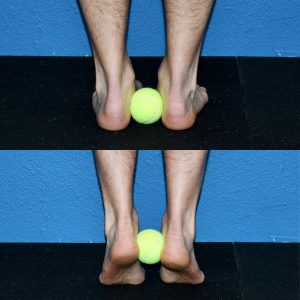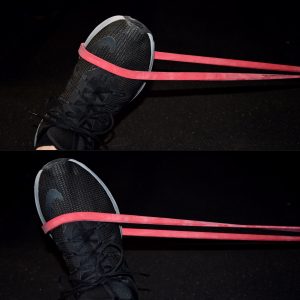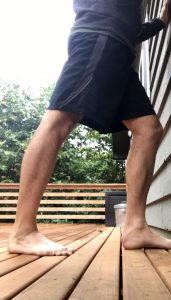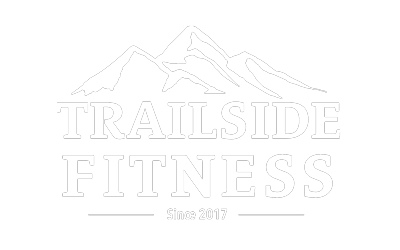Posterior Tibialis Tendonitis
Posterior tibialis tendonitis can be a real pain while hiking! It’s not a big muscle in terms of mass, but it is extremely critical for hiking on rocky terrain and having a stable foot and ankle. The posterior tibialis is an important but often neglected muscle that supports the arch in your foot.
When you walk, it helps to slow the motion of pronation (flattening of the arch) as well as assisting in supination (re-creating the arch), and maintaining the overall arch shape. 
The posterior tibialis lives deep behind the shin bone (tibia) and is largely obscured by other calf muscles.
There is one place near the inside of your ankle that is accessible and that will be our target for massage.
What does posterior tibialis feel like?
It should be noted that any sort of self diagnosis is not advised, and this article merely acts a guide.
It is not intended to diagnose or treat any issue you may be dealing with. If you suspect tendonitis, a quick trip to a medical professional is a smart and responsible action.
Common symptoms:
- Slow and gradual pain or discomfort on the below the inside ankle bone.
- Pain may be dull at first and progress to sharp.
- Tender to touch, maybe light swelling near the inside ankle bone
- In the beginning pain may decrease with a warmup but in later stages,​ it will be noticeable at rest and be worse with hiking.
Causes & healing times for posterior tibialis tendonitis
The causes listed here are typically at the root of most hiker foot problems. These same issues can create aches and pains further up the body including ankles, knees, hips, and low back. First up is over pronation, which is an over flattening of your foot when you place weight on it.
A second common issue is overuse. If you take on too many miles to soon while hiking, the muscles have’t had time to adjust and you overwork them. Lastly, poor footwear choice. Either not the right shoe for your foot or selected activity.
Healing time will vary greatly. Tendon injuries take longer to heal than muscle due to lower blood flow which is needed to bring in the nutrients and other components of healing. Rest or lowered activity are common along with properly selected exercises and footwear to address the problem.
What if I just pretend it isn’t there?
It’s an option, sure, but is it the best one? By ignoring the pain and just figuring it’s part of the process of long-distance hiking (it’s not) then you set yourself up for lots more hurt than you bargained for. Not to mention possibly ending your hike early due to injury. Without intervention you’ll begin to lose​ strength, ankle stability, foot motion and possibly much worse.
How do I manage posterior tibialis tendonitis?
Aside from rest and a doctor visit, here are some of the ways manage this issue.
 REST. Stop doing the thing that irritates it, which is hiking and walking.
REST. Stop doing the thing that irritates it, which is hiking and walking.
If absolutely must continue, a heel wedge to raise your heel height with arch support typically feels much better.
Notice in the photo how this hiker overpronates in the top photo. With shoes offering better arch support she has reduced the stress and strain on multiple foot areas.
Popular shoes aren’t always the best option!
Zero drop shoes may not offer you the support you need, and you should seriously consider changing it up!
Exercises to strengthen and support
Heel raise with a ball squeeze.This exercise variation will help to engage the tibialis posterior more than a traditional heel raise. 
To perform: Place a tennis ball between your heel bones
Squeeze the ball as you rise onto the balls of your feet
Slowly return to the start position
Complete 3 sets of 15 and work up to 4 sets of 20
This exercise activates the posterior tibialis muscle and is an effective way to strengthen this crucial muscle.
Just add this exercise into your routine 2-3 times per week.
It works well between larger exercises sets during your rest times.
Resisted Adduction. This movement will strengthen the lower leg muscles and foot muscles needed for a strong foot. Try to keep the motion just through the ankle and avoid rotating your entire leg to get the motion.
 To perform:
To perform:
Using a resistance band anchored to a stable object, place the band around your foot at the big toe joint.
In a controlled manner, pull your foot inward.
Avoid rotating the lower leg and/or hip and keep the motion just through the foot and ankle.
Slowly and with control, return to the start position. Begin with 3 sets of 15 working up to 4 sets of 20.
Focus on quality of reputations not quantity. Once these are easy at 4 sets of 20, increase the resistance.
Stretch for the lower leg
 There are two stretches that will work well here and should look familiar.
There are two stretches that will work well here and should look familiar.
This image shows a straight back leg which is the traditional runners stretch.
Keep your hips facing forward and parallel to the wall; they may want to rotate towards your back leg.
Keep the weight even across the bottom of your foot; for this, I think of a tripod with the big toe, pinky toe and heel.
Hold for 20 seconds, repeat 3 times. Complete 3-4 times per day.
You can reach me info@trailsidefitness.com with any injury issues, past or present that you feel will impact your hike. Training questions are also welcome – I am happy to help!
Be sure to like my Facebook page and follow us on Instagram and Twitter!


Recent Comments